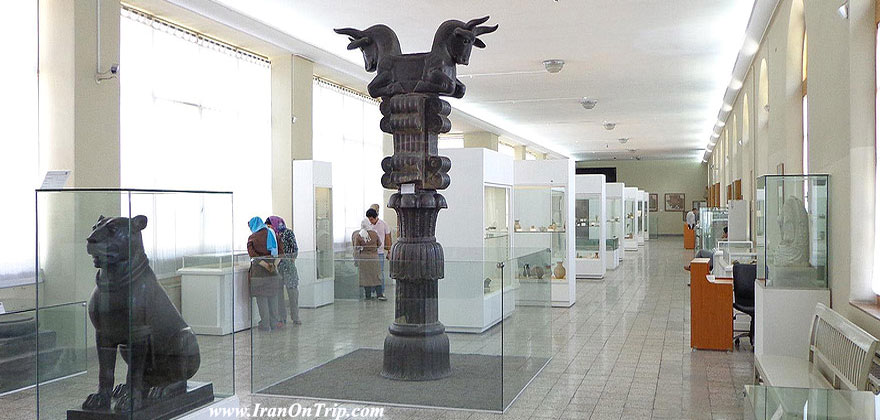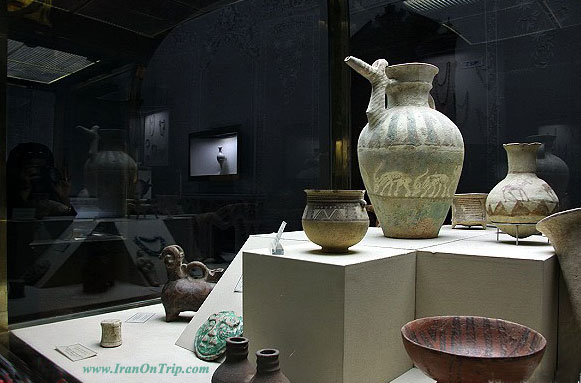Museums of Iran

National Museum of Persia
National Museum of Iran, aging more than 70 years, containing 300,000 museum objects in an area more than 20,000 square meters, is not only the largest museum of History and Archaeology of the country, but ranks as one of the few most prestigious museums of the world in regard to grand volume, diversity and quality of its huge monuments. In the Iranian museum tradition it is considered Iran’s mother museum, aiming at preserving relics of the past to hand down to the next generations, enhancing better understanding among world peoples and nations, discovering and showing Iranian’s roles in shaping world culture and civilization and trying to enhance public knowledge
================================================================================Museums of Tehran&Tehran's Museums
Tehran National Jewelry Museum
.jpg)
The Treasury of Iranian National -Royal- Jewels accommodates the world's most precious jewelry collection. The treasury has an interesting history, going back centuries. The actual value of the treasury is not known. I the past 25 centuries, the Iranian kings were compiling jewels and ornaments whenever the country was in peace. The royal courts and the treasures of the Sassanid kings, Khosrow Parviz in particular, are mythical and have a special place in history books. Regrettably enough, there is not much information available over the quality of jewelry existing in the courts of the Iranian kings. The only valid information concerns the Safavid dynasty. Information comes predominantly from the travelogues of foreign tourists such as Anthony Jenkins, John Baptist Tavernier, Knight Chardin, Shirley Brothers and George Minvaring. Read more
Tehran Golestan Palace Museums
.jpg)
The Arg was built during the reign of Tahmasb I (r. 1524-1576) of the Safavid dynasty (1502-1736), and was later renovated by Karim Khan Zand (r. 1750-1779). Agha Mohamd Khan Qajar (1742-1797) chose Tehran as his capital. The Arg became the site of the Qajar (1794-1925).Court and Golestan Palace became the official residence of the royal family.During the Pahlavi era (1925-1979)Golestan Palace was used for formal royal receptions. The most important ceremonies to be held in the Palace during the Pahlavi era were the coronation of Reza Khan (r. 1925-1941) in Takht-e Marmar and the coronation of Mohammad Reza Pahlavi (r. 1941-deposed 1979) in the Museum Hall.Read more
Tehran Reza Abbasi Museum
.jpg)
The Reza Abbasi Museum (the RAM) opened in September 1977, but in November 1978, just one year after its official opening it was closed. Exactly a year later in 1979, having had changes in its internal decorations and with further expansion of its exhibition space it was reopened. In 1984, because of some internal difficulties, once more it was closed and again reopened in 1985. And finally on February 4, 2000, it was opened for the fifth time, after its renovation.Read more
Tehran Niavaran Palace Museum
.jpg)
Niavaran Cultural - Historical Complex is situated in the north eastern part of Tehran (Shemiranat). Its formation dates back to the Qajar Dynasty. This Complex which has been changed to a museum after the Islamic Revolution was administered jointly with Sa’adabad Complex till 1378 AH (1999), and became independent in 1379 AH (2000). Presently, it is comprised of five museums (Niavaran Palace Museum, Ahmad Shahi Pavilion, Sahebqaranieh Palace, Jahan Nama museum and the private library), and other cultural, historical and natural attractions including the Blue Hall, Private Cinema, Jahan Nama Gallery, and Niavaran Garden.Read more
Iran National Car Museum
.jpg)
The National Car Museum of Iran opened in 2001 in Karaj, a city about 11km west of Tehran. The museum boasts 40 classic automobiles in its collection which were owned by the last Shah of Iran. One of these automobiles is a· British red Morris Oxford from the first days of 20th century that is labeled as the oldest car in Iran. When you enter the museum, you see 2 chariots one in blue and one in black from 150 years ago.· A Mercedes Benz 500K is one of the valuable assets of· the museum. It was a gift from Hitler to the crown prince of Iran, Mohamad Reza Pahlavi. The collection also includes several beautiful Rolls Royce’s including a Siver Spiri.Read more
Tehran Museum of Contemporary Art
.jpg)
As a contemporary example of Iranian architecture, its design has been inspired by certain traditional Iranian as well as modern architecture. This architectural style is inspired by the wind-towers of Iran and was designed by the Iranian architect Kamran Diba. It is built in three floors and has been used as a permanent exhibition since 1977. The Museum of Contemporary Art has nine galleries, three of which are dedicated to paintings by international artists from the museum's permanent collection. The permanent collection contains paintings from artists such as Claude Monet, Vincent van Gogh, Pablo Picasso, René Magritte, Andy Warhol and many more. Temporary exhibitions are held in the other six galleries throughout the year.Read more
Tehran Carpet Museum
.jpg)
Carpet-weaving is undoubtedly one of the most distinguished manifestations of Iranian culture and art, dating back to the Bronze Age, but as the materials used in carpets including wool and cotton, decay into dust during the course of time, archaeologists couldn't make any special discovery during the archaeological excavations. What have remained for us from the early ages as evidence of carpet-weaving are nothing more than a few pieces of worn-out rugs.Such fragments do not help very much in recognizing the carpet-weaving characteristics of pre-Seljuk period (13th and 14th centuries AD). Among the oldest pieces discovered are those found in Eastern Turkestan, dating back to the third to fifth centuries AD, and also some of the hand-weavings of the Seljuks of Asia Minor on exhibit in Ala’edin Mosque in KonyaRead more
Tehran Saadabad Palace Museums
.jpg)
The Sadabad Palace is a palace built by the Pahlavi dynasty of Iran in the Shemiran area of Tehran.The complex was firstinhabited by Qajar monarchs and royal family in the 19th century. After an expansion of the compounds, Reza Shah lived there in the 1920s. And his son, Mohammad Reza Pahlavi moved there in the 1970s. After the Iranian Revolution, the complex became a museum. However, the current presidential palace is located adjacent to the Sa'd Abad compound. Sad Abad has 18 palaces, which 7 palaces had changed to museums.Read more
Tehran National & Islamic Period Museums
|
|
|
National (or Archaeological) Museum of Iran-also called Muze-ye -Iran- e- Bastan (Museum of Ancient Iran) consists of two buildings. Bldg. No 1 has the entire pre-Islamic remaining works, Bldg. No.2 has post-Islamic works. This part was inaugurated at 1996 and consists of 3 floors. The first floor is the meeting and temporary exhibition hall. Works and objects of Islamic culture, Islam art in relation to objective and periodic method are collected in the second and third floors.The objects selected for this large museum, are mostly selected out of excavation or from prominent collections.In designing this museum, instruments related to architecture of historical buildings are presented, at the same time, to explain their actual position.Read more
Tehran Glassware & Ceramic Museum, Abgineh Museum The premises that have been turned into museum where glass and clay works are on display were built about 90 years ago upon orders of Ahmad Qavam (Qavam-ol-Saltaneh) for his personal lodging (residence and working office). The building is situated in a garden with a span of 7000 square meters and was used by Qavam himself till the year 1953.Later, the building were sold to the Egyptians as the new premises for the embassy of Egypt and remained in their possession for seven years. When relations were strained between Iran and Egypt at the time of Abdul Nasser and subsequent to the closure of the Egyptian embassy in Iran, the Commercial Bank purchased the building.Read more
The premises that have been turned into museum where glass and clay works are on display were built about 90 years ago upon orders of Ahmad Qavam (Qavam-ol-Saltaneh) for his personal lodging (residence and working office). The building is situated in a garden with a span of 7000 square meters and was used by Qavam himself till the year 1953.Later, the building were sold to the Egyptians as the new premises for the embassy of Egypt and remained in their possession for seven years. When relations were strained between Iran and Egypt at the time of Abdul Nasser and subsequent to the closure of the Egyptian embassy in Iran, the Commercial Bank purchased the building.Read more
.....
.....
.....

.jpg)

.jpg)
.jpg)


























